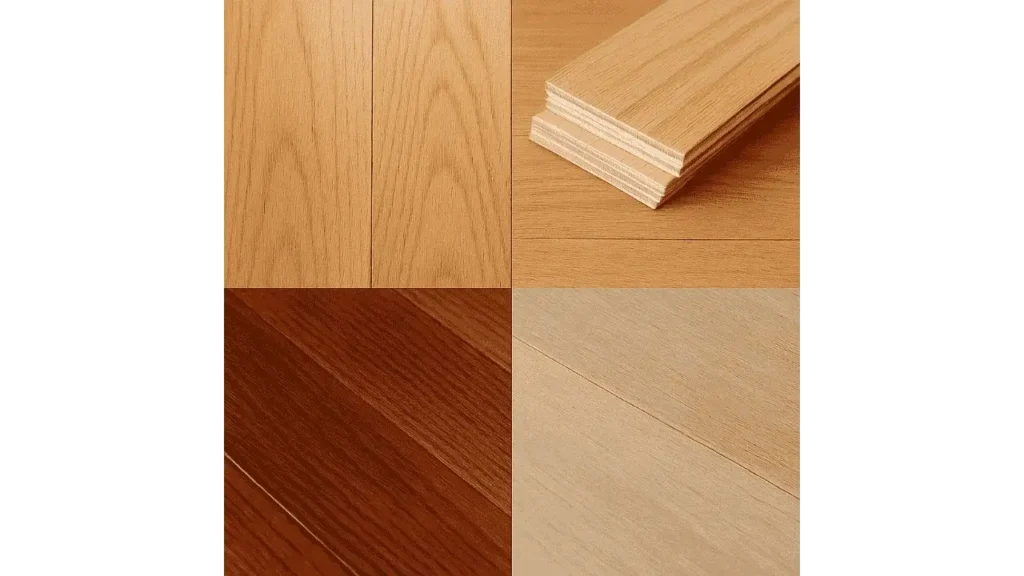Identifying the type of wood flooring in your home is essential for proper maintenance, refinishing, and matching with new flooring. Wood floors come in a wide variety of species, finishes, and constructions, and knowing exactly what you have can help you preserve its beauty and longevity. This guide will help you distinguish between hardwood and softwood floors, recognize common wood species, and use simple steps to identify your flooring.

Understanding Hardwood vs Softwood:
The first step in identifying your wood floor is determining whether it’s hardwood or softwood. Hardwood floors are made from deciduous trees, such as oak, maple, and walnut, which are denser and more durable. Softwood floors come from coniferous trees like pine and fir, offering a softer, more rustic look but are prone to dents and scratches.
Common Types of Hardwood Floors:
1: Oak Flooring
Oak is one of the most popular hardwood flooring types. It features a prominent grain pattern and is available in red and white varieties. Red oak has warm tones, while white oak has cooler, grayish undertones.
2: Maple Flooring
Maple wood is smooth with subtle grain patterns and a light, creamy color. It’s known for its durability and is commonly used in high-traffic areas.
3: Cherry Flooring
Cherry flooring has a rich, reddish-brown hue that darkens over time. It has a smooth texture and subtle grain, offering a luxurious and warm appearance.
4: Walnut Flooring
Walnut is prized for its deep, rich chocolate-brown tones and straight, uniform grain. It’s softer than oak but adds elegance to any space.
5: Hickory Flooring
Hickory is a hard, durable wood with a varied grain pattern and color ranging from light tan to deep brown. It’s ideal for rustic or country-style interiors.
Read More: How to Apply Poly on Hardwood Floors for a Stunning Finish?
Common Types of Softwood Floors:
Pine
Pine floors have a soft, rustic appearance with visible knots and grains. They range in color from pale yellow to deep amber.
Spruce
Spruce flooring has a light color and subtle grain patterns. It’s softer than pine and best suited for low-traffic areas.
Cedar
Cedar is recognized for its natural aroma and reddish hues. It’s soft and lightweight but provides a warm, inviting feel.
Fir
Fir flooring features a tight, straight grain and ranges from light yellow to amber. It’s a common choice for vintage homes and cabin-style decor.
Wood Floor Identification:
Step 1: Examine the Grain Pattern
Look closely at the grain. Open, prominent grains often indicate oak or ash, while smoother, more uniform grains may suggest maple or cherry.
Step 2: Analyze the Color and Texture
Identify natural color tones. Dark, rich hues may suggest walnut or cherry, while lighter tones may indicate maple, pine, or oak.
Step 3: Consider Age and Wear
Older floors with a patina or wear marks could hint at vintage woods like pine or fir. Newer floors may use engineered or exotic woods.
Step 4: Seek Professional Assistance
If you’re unsure, consult a flooring professional. They can identify the wood species and recommend the best care practices.
Step 5: Compare with Known Samples
Compare your floor to wood samples from flooring stores or online galleries to identify similar grain and color patterns.
Step 6: Use Online Resources
Many websites and apps allow you to upload photos and compare them to extensive wood species databases.
Wood Floor Identification Chart:
A wood floor identification chart can be a helpful visual tool. These charts compare grain patterns, colors, and hardness levels across various wood species, making it easier to pinpoint the type of wood in your home.
Wood Floor Identification Apps:
There are mobile apps designed to help identify wood species. Apps like Wood Database and ID Wood provide databases of wood grains and textures, making identification more convenient.
Conclusion:
Identifying your wood flooring is key to proper maintenance and achieving the desired look in your space. By understanding grain patterns, color, texture, and wood type, you can better care for your floors and make informed design decisions. Whether it’s a classic oak or a rustic pine, knowing your wood floor ensures its beauty and durability for years to come.
